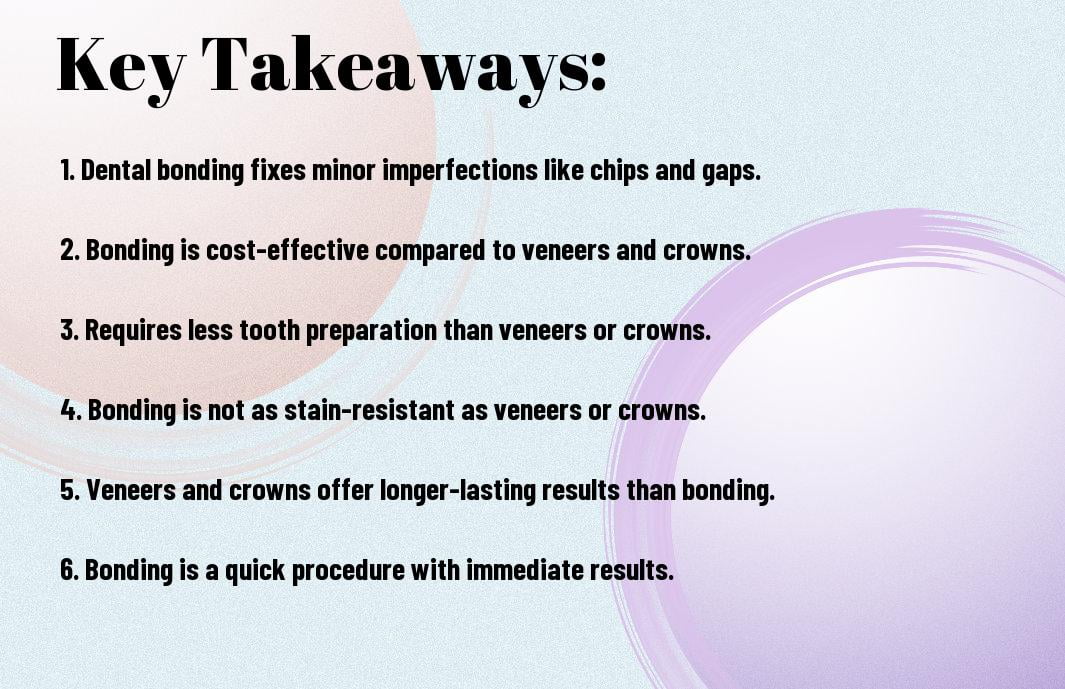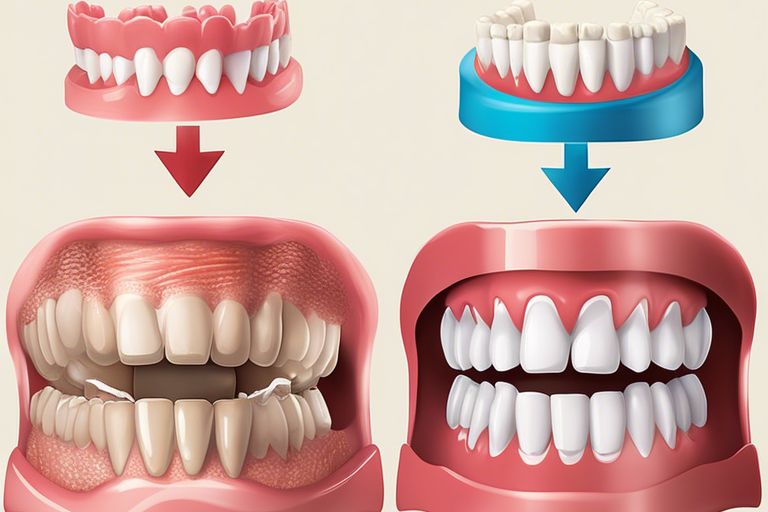You may be considering various cosmetic dental treatments to enhance your smile, and one popular option is dental bonding. However, it’s crucial to understand how it stacks up against other cosmetic procedures. From veneers to teeth whitening and dental implants, each treatment offers unique benefits and considerations. In this blog post, we will compare dental bonding with other cosmetic options to help you make an informed decision about the best choice for your smile.
Key Takeaways:
- Dental bonding is a more affordable cosmetic treatment option: Compared to other procedures like veneers or crowns, dental bonding is generally more cost-effective, making it an attractive choice for those on a budget.
- Dental bonding is a versatile treatment: Bonding can be used to address various cosmetic issues such as chipped or discolored teeth, gaps between teeth, and even reshaping of teeth. This versatility makes it a popular choice for many patients.
- Dental bonding may not be as durable as other treatments: While bonding can provide satisfactory results, it may not be as long-lasting as procedures like veneers or crowns. Patients should consider this factor when deciding on the most suitable cosmetic treatment for their needs.

Understanding Dental Bonding
What is Dental Bonding?
One of the popular cosmetic dental treatments, dental bonding is a procedure where a tooth-colored resin material is applied and hardened with a special light, bonding it to the tooth to improve the overall appearance. This treatment can be used to repair chipped, cracked, discolored, or misaligned teeth.
The Dental Bonding Procedure
Understanding the dental bonding procedure is important for those considering this cosmetic treatment. The process involves roughening the surface of the tooth, applying a conditioning liquid, and then applying the resin. The resin is then shaped, hardened with a special light, and polished to blend seamlessly with the natural tooth. One of the key advantages of dental bonding is that it is a quick and minimally invasive procedure, with results visible in just one visit to the dentist.
However, it’s crucial to note that dental bonding may not be as stain-resistant or long-lasting as other cosmetic treatments like veneers or crowns, and may require touch-ups or replacements over time. Patients should also be aware that the resin material used in bonding can chip or break under pressure, so caution is advised when biting on hard objects.
Popular Cosmetic Dental Treatments
Porcelain Veneers
The application of porcelain veneers is a popular choice for those looking to enhance the appearance of their smile. These custom-made shells are designed to cover the front surface of the teeth, improving their shape, color, and symmetry. The process involves minimal tooth preparation, making it a relatively non-invasive option for achieving a stunning smile.
Teeth Whitening
On the other hand, teeth whitening is a quick and cost-effective way to brighten your smile. This procedure helps eliminate stains and discoloration, leaving you with a brighter and more youthful appearance. Results can be seen in just one visit to the dentist or through at-home kits prescribed by dental professionals.
Cosmetic dental treatments such as teeth whitening are safe when done under the supervision of a licensed dentist. While over-the-counter products are available, the professional whitening process ensures optimal results with minimal risk of damage to the teeth or gums.
Dental Crowns
Dental crowns are tooth-shaped caps that are placed over damaged or weakened teeth to restore their shape, size, and strength. This procedure is often recommended for individuals with severe decay, fractures, or large fillings that compromise the tooth’s integrity.
Dental crowns are custom-made to blend seamlessly with your natural teeth, providing both cosmetic enhancement and functional support. With proper care, these restorations can last for many years, improving both the appearance and functionality of the smile.
Invisalign Orthodontics
Invisalign orthodontics offer a discreet and convenient option for straightening misaligned teeth. Unlike traditional braces, Invisalign utilizes clear aligners that are virtually invisible when worn, making it an attractive choice for those seeking a more aesthetically pleasing orthodontic treatment.
Dental professionals recommend Invisalign for mild to moderate orthodontic issues, providing patients with a comfortable and effective alternative to traditional braces. The removable aligners allow for easier maintenance of oral hygiene and offer a more flexible approach to achieving a straighter smile.
Another key benefit of Invisalign is the ability to correct bite issues, improving not only the aesthetics of the smile but also the overall dental health of the patient. Patients can enjoy a more confident smile while avoiding the discomfort and inconvenience often associated with traditional orthodontic treatments.
Comparing Dental Bonding to Other Treatments
Cost Comparison
| Dental Bonding | Other Cosmetic Treatments |
| Affordable option | Can be more expensive |
Comparing the cost of dental bonding to other cosmetic treatments, dental bonding is generally a more affordable option. While prices can vary depending on the extent of the treatment and materials used, bonding typically offers a cost-effective solution for improving the appearance of your teeth.
Procedure Duration and Convenience
| Comparing | Other Treatments |
| Quick and convenient | May require multiple appointments |
Other cosmetic treatments may involve multiple appointments and longer procedure durations compared to dental bonding. Bonding is usually a quick and convenient solution that can be completed in just one visit to the dentist. This makes it a popular choice for those looking to improve their smile without extensive treatment times.
Durability and Maintenance
An important consideration when comparing the durability of dental bonding to other cosmetic treatments is that bonding can be more prone to chipping and staining compared to materials like porcelain veneers or crowns. While bonding can last for several years with proper care, it may require more frequent touch-ups and maintenance to maintain its appearance.
Aesthetic Outcomes
For optimal aesthetic outcomes, it’s crucial to consider that while dental bonding can provide natural-looking results, it may not be as lifelike or durable as other cosmetic treatments like porcelain veneers. Bonding can be a great option for minor cosmetic improvements, but for more extensive changes or long-term aesthetic goals, other treatments may offer superior outcomes.
Considerations for Choosing a Cosmetic Dental Treatment
Evaluating Your Dental Needs
After deciding to enhance your smile with a cosmetic dental treatment, the first step is to evaluate your dental needs. Consider factors such as the condition of your teeth, the specific issues you want to address, and your overall oral health.
The Role of Personal Oral Care Habits
Dental procedures like bonding, veneers, or teeth whitening can significantly improve your smile, but the longevity of the results relies heavily on your personal oral care habits. Regular brushing, flossing, and routine dental check-ups are necessary for maintaining the effects of cosmetic treatments.
For instance, neglecting oral hygiene can lead to plaque buildup, gum disease, and tooth decay, which can compromise the results of your cosmetic dental treatment.
Summing up
Following this comparison between dental bonding and other cosmetic treatments, it is evident that dental bonding offers a cost-effective and versatile solution for addressing various dental issues. While other treatments like veneers and crowns have their advantages, dental bonding stands out for its simplicity, quick procedure, and minimal tooth preparation. Ultimately, the choice between these treatments depends on individual needs, budget, and aesthetic goals. Consulting with a dental professional can help determine the most suitable option for achieving a beautiful and lasting smile.
FAQ
Q: What is dental bonding and how does it compare to other cosmetic treatments?
A: Dental bonding is a cosmetic procedure in which a tooth-colored resin material is applied and hardened with a special light, bonding it to the tooth to improve its appearance. Compared to other cosmetic treatments such as veneers or crowns, dental bonding is a more affordable option that can usually be done in a single visit to the dentist.
Q: What are the advantages of choosing dental bonding over other cosmetic treatments?
A: Dental bonding offers several advantages over other cosmetic treatments. It is a quick and relatively painless procedure that requires minimal to no removal of enamel. Dental bonding can also be used to repair chipped or cracked teeth, close gaps between teeth, and change the shape or color of teeth, providing a versatile solution for various dental concerns.
Q: Are there any limitations to dental bonding compared to other cosmetic treatments?
A: While dental bonding is a great option for many patients, it does have some limitations when compared to other cosmetic treatments. The resin used in bonding is not as stain-resistant as materials used in veneers or crowns, so it may require more frequent touch-ups or replacements. Additionally, dental bonding is not as durable as other treatments and may need to be repaired or replaced more often, especially for patients who grind their teeth or bite their nails.






